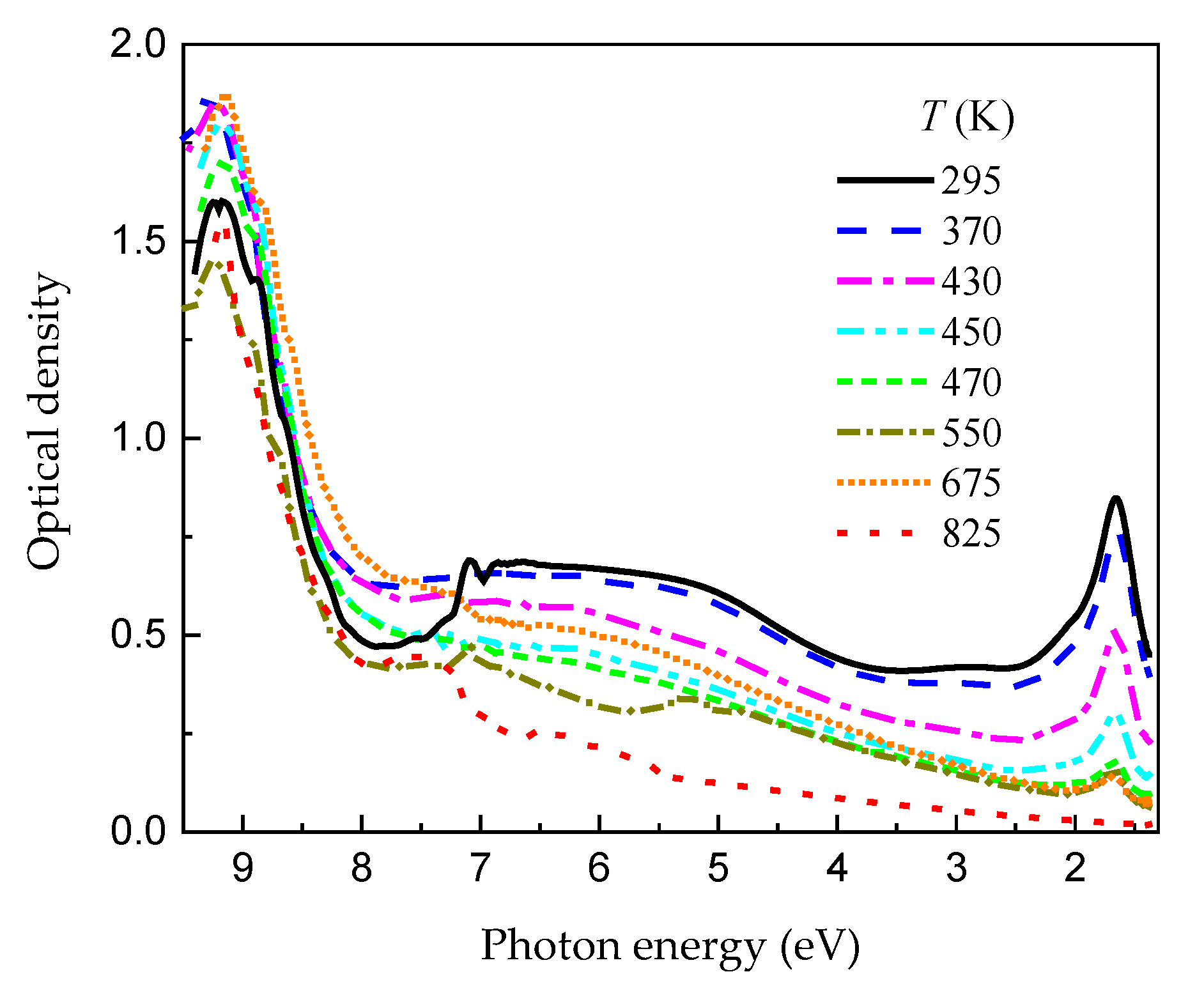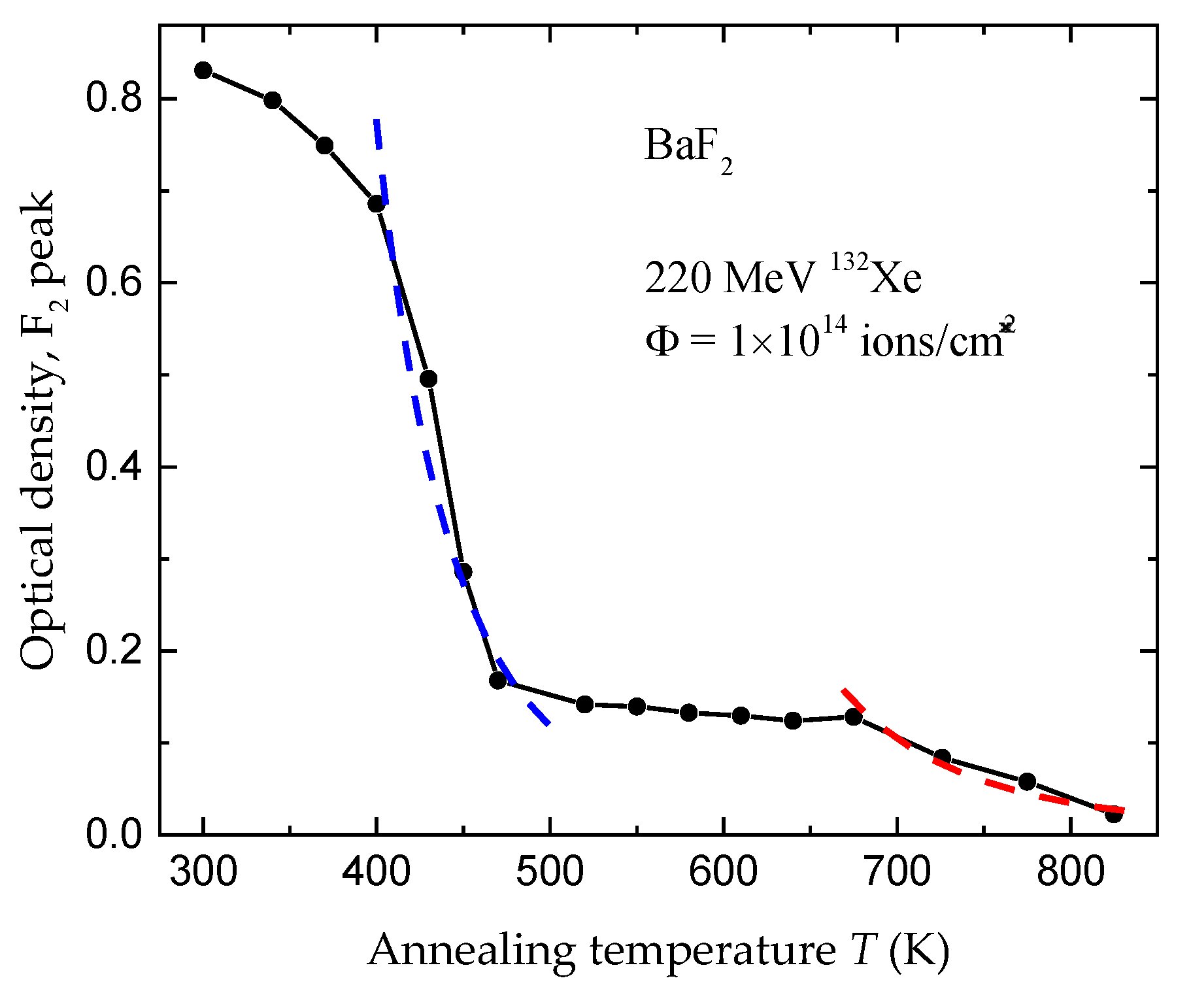Creation and Stability of Color Centers in BaF2 Single Crystals Irradiated with Swift 132Xe Ions
Abstract
1. Introduction
2. Materials and Methods
3. Results and Discussion
| Center | Absorption Maximum (eV) |
|---|---|
| F2 | 1.62 |
| F3 | 1.83, 3.04 |
| F4 | 2.24 |
| V2 (F3−) | 6.5 |
4. Conclusions
Author Contributions
Funding
Data Availability Statement
Acknowledgments
Conflicts of Interest
References
- Lecoq, P.; Gektin, A.; Korzhik, M. Inorganic Scintillators for Detector Systems. In Physical Principles and Crystal Engineering, 2nd ed.; Springer Nature: Berlin/Heidelberg, Germany, 2017. [Google Scholar] [CrossRef]
- Kubota, S.; (Gen) Ruan, J.; Itoh, M.; Hashimoto, S.; Sakuragi, S. A new type of luminescence mechanism in large band-gap insulators: Proposal for fast scintillation materials. Nucl. Instrum. Methods Phys. Res. A 1990, 289, 253–260. [Google Scholar] [CrossRef]
- van Eijk, C. Cross-luminescence. J. Lumin. 1994, 60–61, 936–941. [Google Scholar] [CrossRef]
- Kirm, M.; Nagirnyi, V.; Vielhauer, S.; Feldbach, E. Relaxation and interaction of electronic excitations induced by intense ultra short light pulses in BaF2 scintillator. In Proceedings of the Damage to VUV, EUV, and X-Ray Optics III, Prague, Czech Republic, 18–21 April 2011. [Google Scholar] [CrossRef]
- Cadatal-Raduban, M.; Mui, L.V.; Yamashita, M.; Shibazaki, Y.; Shimizu, T.; Sarukura, N. Pressure-controlled luminescence in fast-response barium fluoride crystals. NPG Asia Mater. 2024, 16, 50. [Google Scholar] [CrossRef]
- Khanin, V.; Venevtsev, I.; Rodnyi, P. Recent advances in the study of core-valence luminescence (cross luminescence). Review. Opt. Mater. 2023, 136, 113399. [Google Scholar] [CrossRef]
- Nicoara, I.; Stef, M.; Vizman, D. Influence of growth conditions on the optical spectra of gamma irradiated BaF2 and CaF2 crystals. J. Cryst. Growth 2019, 525, 125188. [Google Scholar] [CrossRef]
- Rodnyi, P.A. Electron-hole and exciton processes in CaF2, SrF2, and BaF2 crystals (Review). Phys. Solid State 2024, 66, 155–171. [Google Scholar]
- Smakula, A. Color Centers in Calcium Fluoride and Barium Fluoride Crystals. Phys. Rev. 1950, 77, 408. [Google Scholar] [CrossRef]
- Ziegler, J.F. SRIM—The Stopping and Range of Ions in Matter. 2013. Available online: http://www.srim.org/ (accessed on 23 July 2025).
- El-Said, A.S.; Cranney, M.; Ishikawa, N.; Iwase, A.; Neumann, R.; Schwartz, K.; Toulemonde, M.; Trautmann, C. Study of heavy-ion induced modifications in BaF2 and LaF3 single crystals. Nucl. Instrum. Methods Phys. Res. B 2004, 218, 492–497. [Google Scholar] [CrossRef]
- Ishikawa, N.; Taguchi, T.; Okubo, N. Hillocks created for amorphizable and non-amorphizable ceramics irradiated with swift heavy ions: TEM study. Nanotechnology 2017, 28, 445708. [Google Scholar] [CrossRef]
- El-Said, A.S. Fabrication of triangular pits in barium fluoride single crystals by localized electronic excitations. Results Phys. 2023, 51, 106708. [Google Scholar] [CrossRef]
- Chen, J.; Lin, L.; Jing, F. The electronic structure of color centers in BaF2. Nucl. Instrum. Methods Phys. Res. B 2002, 187, 354–360. [Google Scholar] [CrossRef]
- Bochkareva, E.S.; Sidorov, A.I.; Yurina, U.V.; Podsvirov, O.A. Formation of metal nanoparticles in MgF2, CaF2 and BaF2 crystals under the electron beam irradiation. Nucl. Instrum. Methods Phys. Res. B 2017, 403, 1–6. [Google Scholar] [CrossRef]
- Davidson, A.T.; Schwartz, K.; Comins, J.D.; Kozakiewicz, A.G.; Toulemonde, M.; Trautmann, C. Vacuum ultraviolet absorption and ion track effects in LiF crystals irradiated with swift ions. Phys. Rev. B 2002, 66, 214102. [Google Scholar] [CrossRef]
- Soni, H.R.; Gupta, S.K.; Jha, P.K. Electronic and Phonon Properties of BaF2 Studied By Density Functional Methods. AIP Conf. Proc. 2011, 1349, 859–860. [Google Scholar] [CrossRef]
- Knox, R.S.; Teegarden, K.J. Electronic excitations of perfect alkali halide crystals. In Physics of Color Centers; Fowler, W.B., Ed.; Academic Press: New York, NY, USA, 1968; pp. 1–51. [Google Scholar]
- Zakharov, G.N.; Khhudro, A.K.; Mel’chakov, E.N.; Rodnyi, P.A.; Yanovskii, V.V. Radiation defects and thermoluminescence of barium fluoride. Sov. Phys. Solid State 1992, 34, 803–804. [Google Scholar]
- Chen, Y.; Shi, L.; Wang, Y.; Cheng, R.; Yang, J.; Chen, L.; Fan, W.; Dong, J. Internal structural changes in crystals induced by GeV heavy ion beam irradiation of LiF. Acta Phys. Sin. 2024, 73, 156401. [Google Scholar] [CrossRef]
- Batool, A.; Izerrouken, M.; Sorokin, M.V.; Aisida, S.O.; Mushtaq, M.; Hussain, J.; Ahmad, I.; Malik, M.Q.; Faridi, A.; Zhao, T. Effect of point defects on the STE luminescence of CaF2 single crystals. Radiat. Eff. Defects Solids 2023, 178, 314–324. [Google Scholar] [CrossRef]
- den Hartog, H.W.; Klooster, J. Color centers in the alkaline earth fluorides at high temperatures. Phys. Status Solidi 1972, 13, K21–K25. [Google Scholar] [CrossRef]
- Ferraz, G.M.; Matsuoka, M.; Watanabe, S.; Sunta, C.M.; Acharyalu, G.V.S.G.; Srikantaiah, R.V. Thermoluminescence and opitical absorption of BaF2 crystals. Radiat. Eff. Defects Solids 2001, 154, 325–331. [Google Scholar] [CrossRef]
- Sorokin, M.V.; Malikova, Z.B.; Dauletbekova, A.K.; Baubekova, G.; Aralbayeva, G.M.; Akilbekov, A.T. Thermal annealing of radiation damages produced by swift 14N and 16O ions in LiF crystals. Mater. Res. Express 2024, 11, 076201. [Google Scholar] [CrossRef]
- Keeton, S.C.; Wilson, W.D. Vacancies, Interstitials, and Rare Gases in Fluorite Structures. Phys. Rev. B 1973, 7, 834–843. [Google Scholar] [CrossRef]
- Schwartz, K.; Trautmann, C.; Neumann, R. Electronic excitations and heavy-ion-induced processes in ionic crystals. Nucl. Instrum. Methods Phys. Res. B 2003, 209, 73–84. [Google Scholar] [CrossRef]
- Trautmann, C.; Schwartz, K.; Costantini, J.M.; Steckenreiter, T.; Toulemonde, M. Radiation defects in lithium fluoride induced by heavy ions. Nucl. Instrum. Methods Phys. Res. B 1998, 146, 367–378. [Google Scholar] [CrossRef][Green Version]



Disclaimer/Publisher’s Note: The statements, opinions and data contained in all publications are solely those of the individual author(s) and contributor(s) and not of MDPI and/or the editor(s). MDPI and/or the editor(s) disclaim responsibility for any injury to people or property resulting from any ideas, methods, instructions or products referred to in the content. |
© 2025 by the authors. Licensee MDPI, Basel, Switzerland. This article is an open access article distributed under the terms and conditions of the Creative Commons Attribution (CC BY) license (https://creativecommons.org/licenses/by/4.0/).
Share and Cite
Kenbayev, D.; Sorokin, M.V.; El-Said, A.S.; Dauletbekova, A.; Saduova, B.; Aralbayeva, G.; Akilbekov, A.; Shablonin, E.; Bazarbek, A.-D. Creation and Stability of Color Centers in BaF2 Single Crystals Irradiated with Swift 132Xe Ions. Crystals 2025, 15, 785. https://doi.org/10.3390/cryst15090785
Kenbayev D, Sorokin MV, El-Said AS, Dauletbekova A, Saduova B, Aralbayeva G, Akilbekov A, Shablonin E, Bazarbek A-D. Creation and Stability of Color Centers in BaF2 Single Crystals Irradiated with Swift 132Xe Ions. Crystals. 2025; 15(9):785. https://doi.org/10.3390/cryst15090785
Chicago/Turabian StyleKenbayev, Daurzhan, Michael V. Sorokin, Ayman S. El-Said, Alma Dauletbekova, Balzhan Saduova, Gulnara Aralbayeva, Abdirash Akilbekov, Evgeni Shablonin, and Assyl-Dastan Bazarbek. 2025. "Creation and Stability of Color Centers in BaF2 Single Crystals Irradiated with Swift 132Xe Ions" Crystals 15, no. 9: 785. https://doi.org/10.3390/cryst15090785
APA StyleKenbayev, D., Sorokin, M. V., El-Said, A. S., Dauletbekova, A., Saduova, B., Aralbayeva, G., Akilbekov, A., Shablonin, E., & Bazarbek, A.-D. (2025). Creation and Stability of Color Centers in BaF2 Single Crystals Irradiated with Swift 132Xe Ions. Crystals, 15(9), 785. https://doi.org/10.3390/cryst15090785







